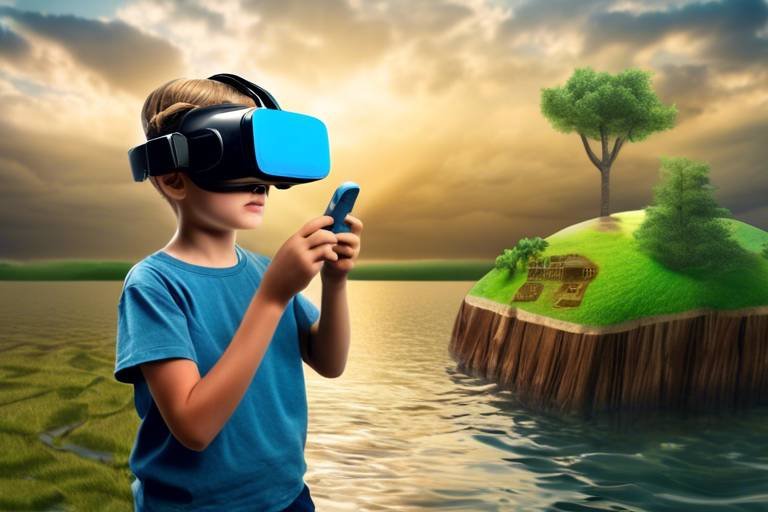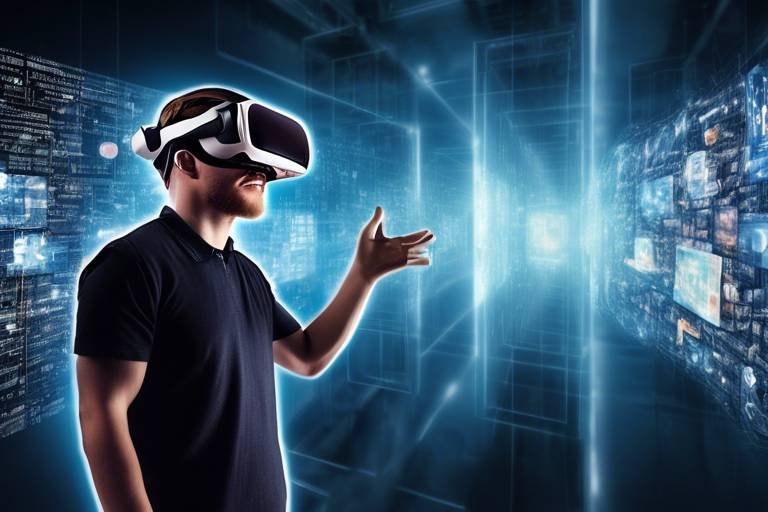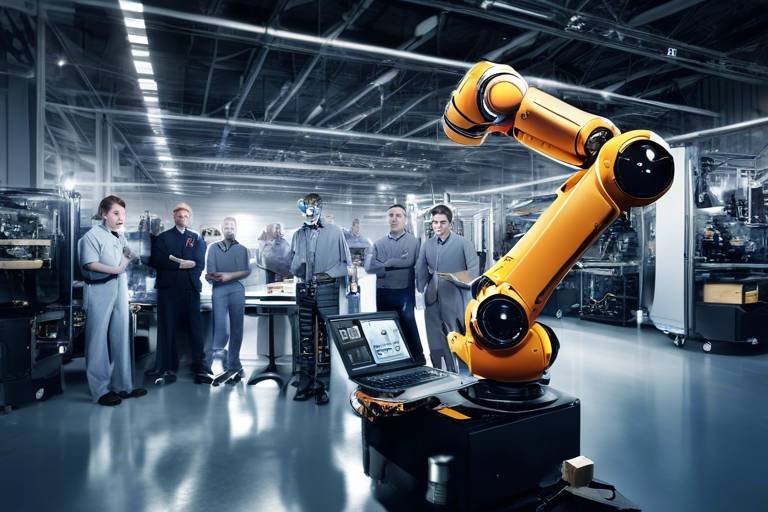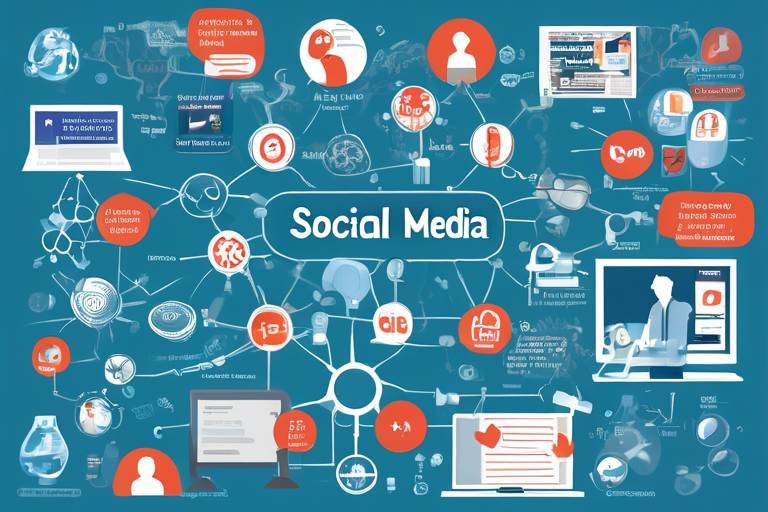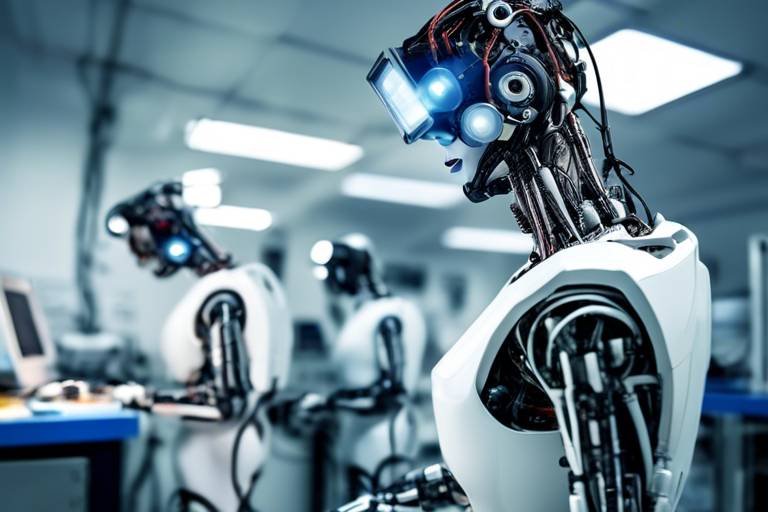The Role of Virtual Reality in Climate Change Education
In an era where climate change is one of the most pressing challenges we face, educating the next generation about environmental issues is crucial. Traditional teaching methods often fall short in conveying the urgency and complexity of climate change. This is where Virtual Reality (VR) steps in as a game-changer. Imagine stepping into a world where you can experience the effects of climate change firsthand. With VR, students can not only learn about the environment but also feel it, interact with it, and understand its fragility in a way that textbooks simply can't offer.
VR technology immerses users in lifelike simulations, allowing them to explore ecosystems, witness the impact of natural disasters, and engage in interactive learning experiences. This immersive approach captures attention and fosters a deeper emotional connection to the material, making it more likely that students will retain and apply what they've learned. As educators, we have the opportunity to harness the power of VR to transform climate change education from passive learning to active engagement.
Moreover, VR can bridge the gap between theory and practice. Students can embark on virtual field trips to remote areas affected by climate change, such as the Amazon rainforest or the Arctic. Here, they can observe the consequences of deforestation, melting ice caps, and rising sea levels. This kind of experiential learning not only enhances understanding but also inspires a sense of responsibility and urgency to act. When students see the world through the lens of VR, they are more likely to become passionate advocates for sustainability.
However, it's essential to recognize that while the potential of VR in climate change education is immense, there are challenges to consider. Accessibility to VR technology can be limited, creating disparities in educational opportunities. Furthermore, the costs associated with VR equipment can be a significant barrier for many schools. To ensure that all students benefit from this innovative approach, we must address these challenges head-on.
As we look to the future, the integration of VR in climate change education holds great promise. Continued advancements in technology may lead to more affordable and accessible VR solutions, making it easier for educators to implement these tools in their classrooms. By embracing this technology, we can equip the next generation with the knowledge and skills they need to combat climate change effectively.
- What is Virtual Reality?
Virtual Reality is a technology that creates simulated environments, allowing users to interact with 3D spaces and experience scenarios that are otherwise difficult to visualize. - How does VR enhance climate change education?
VR enhances climate change education by providing immersive experiences that promote understanding and engagement with environmental issues, making learning more interactive and impactful. - Are there any challenges to implementing VR in education?
Yes, challenges include accessibility issues, high costs of equipment, and the need for proper training for educators to effectively utilize VR technology. - What are some applications of VR in climate change education?
Applications include virtual field trips to affected areas, climate change simulations, and interactive learning experiences that foster critical thinking.

Understanding Virtual Reality
Virtual reality, often abbreviated as VR, is a groundbreaking technology that creates simulated environments, allowing users to immerse themselves in a three-dimensional space. Imagine stepping into a world where you can interact with your surroundings, whether it’s exploring a vibrant coral reef or witnessing the effects of climate change on a polar ice cap. This technology is not just a futuristic concept; it’s a powerful educational tool that can transform the way students learn about complex subjects like climate change.
At its core, VR provides an immersive experience that traditional classrooms simply cannot offer. Instead of reading about environmental issues or watching videos, students can actively engage with the material in a way that feels real. They can walk through a rainforest, observe the impact of deforestation, or even participate in a virtual summit discussing climate policies. This level of engagement is crucial for fostering a deeper understanding of environmental challenges.
The mechanics of VR involve the use of specialized hardware, such as headsets and motion sensors, which track the user's movements and adjust the virtual environment accordingly. This creates a seamless experience where students can look around, interact with objects, and even communicate with virtual characters. The technology behind VR has advanced significantly in recent years, making it more accessible and user-friendly.
Moreover, VR can cater to different learning styles. Some students are visual learners, while others may benefit from hands-on experiences. With VR, educators can create tailored experiences that meet the diverse needs of their students. For instance, a student who struggles with abstract concepts can visualize the greenhouse effect in a 3D format, making it easier to grasp the implications of climate change.
In summary, understanding virtual reality is essential for recognizing its potential in climate change education. By offering immersive, interactive experiences, VR not only captures students' attention but also enhances their understanding of urgent environmental issues. As we delve deeper into the applications of VR in education, it becomes clear that this technology is not just a trend; it’s a vital tool for shaping the minds of future environmental advocates.

Benefits of VR in Education
Utilizing Virtual Reality (VR) in educational settings provides a plethora of benefits that can revolutionize the way students learn about complex topics, particularly in the realm of climate change. Imagine stepping into a world where you can witness the melting of glaciers or the effects of deforestation firsthand, all from the comfort of your classroom. This level of immersion fosters a deeper connection to the material, making the learning experience not just informative but also transformative.
One of the most significant advantages of VR is its capacity to enhance engagement. Traditional teaching methods often struggle to capture the attention of students, but VR changes the game entirely. When students are placed in an interactive environment, they are more likely to participate actively in their learning journey. This heightened engagement can lead to a more profound understanding of complex climate issues, as students become emotionally invested in what they are learning. In fact, studies have shown that immersive experiences can lead to a retention rate that is significantly higher than that of conventional methods.
Moreover, VR allows for interactive learning experiences that are simply impossible to replicate in a standard classroom setting. For instance, students can explore diverse ecosystems, observe weather patterns, and witness the direct impacts of climate change on various communities. This hands-on approach not only fosters curiosity but also encourages critical thinking as students analyze the challenges faced by our planet. By engaging with the material in such an interactive manner, students are more likely to develop a sense of responsibility towards environmental stewardship.
Another remarkable aspect of VR is its ability to create real-world simulations. These simulations can model the effects of climate change in real-time, allowing students to visualize potential futures based on current environmental trends. For example, a simulation might illustrate how rising sea levels could impact coastal cities, making the concept of climate change feel immediate and urgent. Experiencing these potential futures can inspire proactive attitudes and behaviors towards sustainability, motivating students to become advocates for change.
In summary, the benefits of VR in education extend far beyond mere entertainment. They encompass increased engagement, improved knowledge retention, and the ability to experience real-world scenarios that make learning about climate change not only relevant but also compelling. As we continue to explore the potential of VR in educational contexts, it is essential to recognize its power in shaping the next generation of environmentally conscious individuals.
- What is Virtual Reality? - Virtual Reality is a technology that creates simulated environments, allowing users to interact with 3D spaces.
- How does VR enhance learning? - VR enhances learning by making it more engaging and interactive, leading to better retention of information.
- Are there challenges in implementing VR in education? - Yes, challenges include accessibility, cost, and the need for proper training for educators.
- What are some applications of VR in climate change education? - Applications include virtual field trips and climate change simulations that provide immersive learning experiences.

Enhanced Engagement
Imagine walking through a lush, vibrant rainforest, surrounded by the sounds of chirping birds and rustling leaves, all while sitting in your classroom. This is the magic of Virtual Reality (VR)—a technology that transports students into immersive environments that feel incredibly real. Enhanced engagement is one of the most significant benefits of using VR in climate change education. When students are placed in scenarios where they can see and interact with the effects of climate change firsthand, their interest skyrockets.
Traditional teaching methods often struggle to capture the attention of students. However, VR captivates them by transforming passive learning into an active experience. Instead of merely reading about the impact of rising sea levels, students can virtually experience a flooded coastal city. This kind of interactive learning not only makes the subject matter more relatable but also stirs emotional responses, leading to a deeper understanding of the issues at hand.
Moreover, VR allows for a level of interactivity that textbooks simply cannot provide. Students can engage with the environment in ways that promote critical thinking. For instance, they might be tasked with making decisions on how to mitigate the effects of a natural disaster in a simulated town. This hands-on approach encourages students to think critically about the consequences of their actions, fostering a sense of responsibility toward environmental stewardship.
To illustrate this point, consider a recent study that highlighted how students who participated in VR-based lessons were more likely to express concern about climate change compared to those who learned through conventional methods. The findings revealed that:
| Learning Method | Concern for Climate Change |
|---|---|
| Traditional Methods | 40% |
| VR-Based Learning | 85% |
This stark contrast underscores how powerful immersive experiences can be in shaping attitudes and behaviors. When students feel they are part of the solution, they are more likely to engage in discussions and activities outside the classroom that promote sustainability.
In conclusion, the enhanced engagement offered by VR not only makes learning about climate change exciting but also instills a sense of urgency and responsibility in students. As they navigate through these virtual worlds, they are not just passive observers; they become active participants in their education and, ultimately, in the fight against climate change.
- What is Virtual Reality?
Virtual Reality is a technology that creates simulated environments, allowing users to interact with 3D spaces. - How does VR improve engagement in education?
VR transforms traditional learning methods into immersive experiences, capturing students' attention and motivating them to learn. - Are there any challenges to using VR in education?
Yes, challenges include accessibility, cost, and the need for proper training for educators. - What are some applications of VR in climate change education?
Applications include virtual field trips and climate change simulations that provide students with a deeper understanding of environmental issues.

Interactive Learning Experiences
Imagine stepping into a world where you can walk through a vibrant rainforest, feel the heat of a melting glacier, or witness the devastating effects of a hurricane—all from the comfort of your classroom. using virtual reality (VR) allow students to engage with complex environmental issues in ways that traditional teaching methods simply cannot match. By immersing students in these dynamic scenarios, they can better understand the intricate relationships within ecosystems and the impact of climate change on our planet.
These experiences are designed to be hands-on and experiential, encouraging students to explore and interact with their surroundings. For instance, students can take virtual field trips to coral reefs, where they can observe the effects of ocean acidification firsthand. This type of learning not only captivates their attention but also fosters a sense of empathy and responsibility toward the environment. When students see the beauty of a thriving ecosystem and then witness its degradation, they are more likely to feel compelled to take action.
Moreover, interactive VR experiences can include various elements that challenge students to think critically. They may be asked to make decisions based on real-time data, such as predicting weather patterns or assessing the impact of human activities on different habitats. This kind of problem-solving enhances their analytical skills and helps them grasp the urgency of climate issues. For example:
| Scenario | Learning Objective | Outcome |
|---|---|---|
| Simulating a forest fire | Understand the role of fire in ecosystems | Students learn about natural cycles and human impact on forests |
| Exploring a melting polar ice cap | Visualize climate change effects | Increased awareness of global warming and its consequences |
| Participating in a community planning meeting | Engage in environmental decision-making | Empower students to advocate for sustainable practices |
In essence, these interactive experiences serve as a bridge between theoretical knowledge and real-world application. They not only make learning enjoyable but also instill a sense of agency in students. When they can see the direct consequences of their actions within a virtual environment, it can ignite a passion for environmental stewardship that lasts a lifetime.
As we look to the future, the potential for VR to transform climate change education is immense. By creating immersive and interactive learning experiences, we can equip the next generation with the knowledge and skills necessary to tackle one of the greatest challenges of our time.
- What is virtual reality? Virtual reality (VR) is a technology that creates simulated environments, allowing users to interact with 3D spaces in a way that feels real.
- How does VR enhance climate change education? VR enhances climate change education by providing immersive experiences that engage students and help them understand complex environmental issues.
- Are there any challenges to using VR in education? Yes, challenges include accessibility, cost, and the need for proper training for educators.
- What are some examples of VR applications in climate education? Examples include virtual field trips to impacted areas, climate change simulations, and interactive decision-making scenarios.

Real-World Simulations
Imagine stepping into a world where you can witness the devastating effects of climate change firsthand, all while sitting in your classroom. in virtual reality (VR) make this possible by transporting students into scenarios that illustrate the urgent challenges our planet faces. These immersive experiences allow learners to see, feel, and understand the consequences of climate change in a way that textbooks simply cannot convey.
Through VR, students can explore a range of simulated environments, from coral reefs suffering from bleaching to bustling urban areas grappling with rising sea levels. This experiential learning approach not only captivates their attention but also fosters a deep emotional connection to the material. When students experience the potential future impacts of climate change, they are more likely to feel a sense of responsibility and urgency to take action.
For instance, a VR simulation might allow students to walk through a virtual rainforest, witnessing the effects of deforestation and the loss of biodiversity. They can interact with the environment, observe how species are affected, and understand the intricate balance of ecosystems. This hands-on exploration encourages critical thinking and discussions about sustainability and conservation efforts.
Moreover, real-world simulations can be tailored to local contexts, making the learning experience even more relevant. For example, students in coastal regions can participate in simulations that demonstrate the impact of rising tides on their own communities. This localized approach not only enhances engagement but also empowers students to think about solutions that can be implemented in their own backyards.
In summary, real-world simulations in VR provide a powerful tool for climate change education. By immersing students in realistic scenarios, they gain a profound understanding of the challenges we face and are inspired to become proactive stewards of the environment. As technology continues to evolve, the potential for these simulations to transform education and foster a generation of informed environmental advocates is truly exciting.
- What is virtual reality? Virtual reality is a technology that creates simulated environments, allowing users to interact with 3D spaces in an immersive way.
- How does VR enhance climate change education? VR provides immersive experiences that engage students, making complex climate issues more relatable and understandable.
- Are there any challenges to implementing VR in education? Yes, challenges include accessibility issues, high costs of equipment, and the need for proper training for educators.
- What are some examples of VR applications in climate change education? Examples include virtual field trips to affected areas and simulations of climate change impacts on ecosystems.

Improved Knowledge Retention
When it comes to learning, traditional methods often fall short in keeping students engaged and retaining information. This is where virtual reality (VR) steps in and shakes things up! Imagine immersing yourself in a 3D environment where you can see, hear, and even interact with the subject matter. Studies have shown that experiential learning through VR significantly enhances knowledge retention. Why? Because when students actively participate in their learning process, they are more likely to remember what they’ve learned.
In the context of climate change education, experiencing the effects of rising sea levels or deforestation in a virtual world makes the information more tangible and memorable. Instead of just reading about these issues in a textbook, students can witness the dramatic changes firsthand. This multi-sensory experience engages various parts of the brain, creating stronger neural connections that help solidify knowledge. It’s like learning to ride a bike; you can read all about it, but until you actually hop on and pedal, the lesson doesn’t truly stick!
Moreover, VR allows for repeated exposure to complex concepts without the fatigue that might come from traditional study methods. Students can revisit scenarios as often as they need, reinforcing their understanding. For example, a student might explore a virtual rainforest ecosystem multiple times, each time discovering new interactions between species and the impact of climate change, which deepens their comprehension.
Additionally, here are a few key factors that contribute to improved knowledge retention through VR:
- Active Engagement: Students are not passive recipients of information; they are active participants, which fosters a deeper connection with the material.
- Emotional Connection: Experiencing the effects of climate change can evoke emotional responses, making the information more relatable and memorable.
- Realistic Context: Learning in a realistic context helps students understand the relevance of what they are studying, further enhancing retention.
In summary, the immersive nature of VR transforms the educational landscape, particularly in climate change education. By engaging students through realistic simulations and interactive experiences, VR ensures that the knowledge they acquire is not just temporary but sticks with them long after the lesson is over. This innovative approach not only prepares them to understand the complexities of climate issues but also empowers them to become proactive advocates for change.
- How does VR improve learning outcomes? VR enhances learning outcomes by providing immersive experiences that engage students actively, making the information more memorable.
- Can VR be used for other subjects besides climate change? Absolutely! VR can be applied across various subjects, including history, science, and even art, to create engaging learning experiences.
- What are some challenges of using VR in education? Challenges include accessibility, cost of equipment, and the need for teacher training to effectively integrate VR into the curriculum.
- Is VR safe for students? Yes, VR is generally safe for students, but proper guidelines and supervision should be in place to ensure a positive experience.
- What is the future of VR in education? The future looks bright, with advancements in technology likely to lead to more affordable and accessible VR solutions for educational institutions.

Applications of VR in Climate Change Education
Virtual reality (VR) is not just a futuristic concept; it is a transformative tool that is reshaping the way we approach climate change education. By immersing students in realistic environments, VR allows them to experience the effects of climate change firsthand. This innovative technology serves various applications that enhance understanding and foster engagement with environmental issues. For instance, virtual field trips can transport students to remote locations impacted by climate change, such as the Great Barrier Reef or the Amazon Rainforest. Imagine standing on a virtual glacier, witnessing its slow melt, or flying over deforested areas—these experiences can leave a profound impact on students.
Another significant application is climate change simulations, which model the effects of environmental changes on ecosystems and communities. These simulations can illustrate scenarios such as rising sea levels, extreme weather events, or habitat loss, allowing students to visualize potential futures. Such immersive experiences not only educate but also evoke emotional responses, fostering a sense of urgency and responsibility toward environmental stewardship.
Moreover, VR can facilitate collaborative learning experiences where students from different geographical locations can come together in a virtual space. This interaction can lead to discussions about local climate issues and global impacts, encouraging a broader perspective on environmental challenges. By engaging with peers in a shared virtual environment, students can develop critical thinking skills and work collaboratively to devise solutions to pressing climate issues.
In addition to these applications, VR can also be integrated into existing curricula across various subjects. For example, science classes can use VR to explore the carbon cycle, while geography lessons can incorporate simulations of weather patterns and climate zones. The versatility of VR makes it a valuable tool for educators looking to enrich their teaching methods and provide students with a more comprehensive understanding of climate change.
To summarize, the applications of VR in climate change education are vast and varied. By providing immersive experiences that allow students to explore and interact with their environment, VR not only enhances learning but also inspires the next generation of environmental advocates. As we continue to innovate and integrate technology in education, the potential for VR to influence climate change awareness and action is truly exciting.
- What is virtual reality?
Virtual reality is a technology that creates simulated environments, allowing users to interact with 3D spaces as if they were real. - How does VR enhance climate change education?
VR enhances climate change education by providing immersive experiences that promote understanding and engagement with environmental issues. - Are there any challenges to using VR in education?
Yes, challenges include accessibility, cost, and the need for proper training for educators. - What are some examples of VR applications in climate education?
Examples include virtual field trips to affected areas and simulations of climate change impacts on ecosystems.

Virtual Field Trips
Imagine being able to stand on the edge of a melting glacier without ever leaving your classroom. offer students a remarkable opportunity to do just that. These immersive experiences transport learners to remote locations around the globe, allowing them to witness the effects of climate change firsthand. It’s like having a passport to the planet, where students can explore ecosystems that are both breathtaking and vulnerable.
One of the most exciting aspects of virtual field trips is their ability to provide a powerful visual context for understanding complex environmental issues. For instance, students can navigate through the Amazon rainforest, observing the impacts of deforestation, or dive into the Great Barrier Reef to see the effects of coral bleaching. This not only enhances their knowledge but also stirs emotional responses that can motivate them to act.
Moreover, virtual field trips can be tailored to fit various educational needs. Teachers can choose specific locations and themes that align with their curriculum, making the learning experience relevant and engaging. Here are a few examples of virtual field trips that can be integrated into climate change education:
- Polar Regions: Explore the Arctic and Antarctic to understand the significance of ice caps and their role in global climate regulation.
- Coastal Areas: Visit coastal cities facing rising sea levels, helping students visualize the potential impacts on human populations.
- Forests: Journey through diverse forests to learn about biodiversity and the consequences of habitat loss.
These experiences are not just about observation; they encourage students to engage actively with the content. They can participate in interactive discussions, answer quizzes, and even collaborate on projects based on their virtual explorations. This kind of engagement fosters a deeper understanding of climate change and its far-reaching effects.
However, while virtual field trips are a fantastic tool, they also require careful planning and execution. Teachers need to ensure that the technology is accessible and that students are adequately prepared to make the most of these experiences. When done right, virtual field trips can ignite a passion for environmental stewardship and inspire the next generation of climate advocates.
- What technology is required for virtual field trips?
Typically, students need a VR headset or a computer with internet access. Many platforms also offer mobile-friendly options. - Are virtual field trips suitable for all age groups?
Yes, virtual field trips can be designed to cater to various age groups, with content tailored to their understanding and interests. - How can teachers integrate virtual field trips into their curriculum?
Teachers can align virtual field trips with specific lessons, using them as a supplementary tool to enhance traditional learning methods.

Climate Change Simulations
Climate change simulations are revolutionary tools that allow students to visualize the profound impacts of climate change on our planet and its ecosystems. By immersing learners in a virtual environment, these simulations create a powerful narrative that goes beyond textbook learning. Imagine walking through a vibrant coral reef, only to witness its slow degradation due to rising sea temperatures. This kind of immersive experience can evoke emotions and foster a deeper understanding of environmental issues.
These simulations often model various scenarios, such as the effects of greenhouse gas emissions on global temperatures, sea-level rise, and extreme weather events. For instance, students might experience a simulation where they are tasked with managing a coastal community facing the threat of flooding due to climate change. They must make decisions about resource allocation, urban planning, and disaster preparedness, all while seeing the immediate consequences of their choices in real-time.
One of the most significant advantages of climate change simulations is their ability to present complex scientific data in a digestible format. Instead of being bombarded with numbers and graphs, students can see the data come to life. For example, a simulation might show the gradual increase in global temperatures over the years, allowing students to witness firsthand how this rise affects weather patterns, agriculture, and wildlife.
Moreover, these simulations can be tailored to address specific local issues, making the learning experience even more relevant. For example, a student in a coastal area might engage with a simulation focused on the impacts of rising sea levels on their community, while a student in a forested region might explore the effects of wildfires exacerbated by climate change. This localized approach not only enhances engagement but also encourages students to think critically about the solutions that can be implemented in their own communities.
As we look to the future, the integration of advanced technologies such as artificial intelligence and machine learning into these simulations could further enhance their effectiveness. Imagine a simulation that adapts in real-time based on the decisions students make, providing instant feedback and alternative scenarios. This level of interactivity could transform how we teach climate science, making it not just a subject to learn but a call to action.
In conclusion, climate change simulations are more than just educational tools; they are gateways to understanding the urgency of environmental issues. By engaging students in immersive, interactive experiences, we empower them to become informed advocates for the planet. The more we can bridge the gap between knowledge and action, the better prepared our future generations will be to tackle the challenges of climate change.
- What are climate change simulations?
Climate change simulations are interactive virtual experiences that allow users to explore the effects of climate change on ecosystems and communities. - How do these simulations enhance learning?
They provide immersive experiences that help students visualize complex data and understand the real-world implications of climate change. - Are climate change simulations accessible to all students?
While many educational institutions are adopting this technology, accessibility can vary. Efforts are ongoing to make VR more available to all students. - What is the future of climate change simulations in education?
As technology advances, we can expect more affordable and engaging simulations that will further inspire students to take action on climate issues.

Challenges and Limitations
While the integration of Virtual Reality (VR) in climate change education offers exciting possibilities, it is not without its challenges and limitations. One of the primary hurdles is accessibility. Not every student has equal access to the necessary VR technology, which can create significant disparities in educational opportunities. Imagine a classroom where some students can explore a virtual rainforest while others are left out simply because they lack the equipment. This inequality can hinder the overall effectiveness of VR as a teaching tool, as it may not reach all learners equally.
Another major consideration is the cost associated with VR technology. The equipment, software, and maintenance can be quite expensive, making it difficult for many educational institutions, especially those in underfunded areas, to incorporate VR into their curricula. Schools often have to make tough choices about where to allocate their limited budgets, and unfortunately, cutting-edge technology like VR can fall by the wayside. To illustrate this point, here’s a simple comparison of the costs involved:
| Item | Estimated Cost |
|---|---|
| VR Headset | $300 - $1,000 |
| VR Software Licenses | $100 - $500 per license |
| Training for Educators | $200 - $1,000 |
In addition to cost and accessibility, there’s also the training required for educators to effectively implement VR into their teaching strategies. Many teachers may not feel comfortable using this technology or may lack the necessary skills to integrate it into their lessons seamlessly. Imagine a teacher who wants to use VR but is unsure how to operate the software or manage the equipment. This can lead to frustration, reduced effectiveness, and ultimately a missed opportunity to engage students in meaningful ways.
Furthermore, there are concerns about the content available in VR. Not all VR experiences are created equal, and some may not provide accurate or comprehensive representations of climate change issues. For instance, if a VR simulation oversimplifies complex ecological interactions or fails to depict the gravity of climate change, it could misinform students rather than educate them. Thus, ensuring that quality content is available is crucial for maximizing the educational potential of VR.
Lastly, while VR can create immersive learning experiences, it cannot replace traditional educational methods entirely. There are many aspects of learning, such as critical discussions and collaborative projects, that benefit from face-to-face interactions. Therefore, a balanced approach that combines VR with other teaching methods may be the best way to foster a well-rounded understanding of climate change.
- What is the main challenge of using VR in education? The main challenges include accessibility, cost, and the need for proper training for educators.
- How can schools overcome the cost barrier of VR technology? Schools can explore funding options, partnerships, and grants to help mitigate financial challenges.
- Is VR a replacement for traditional teaching methods? No, VR should complement traditional methods, as face-to-face interactions and discussions are also important for learning.
- What types of content should be prioritized for VR in climate education? High-quality, accurate, and comprehensive content that reflects the complexity of climate issues is crucial for effective learning.

Accessibility Issues
When it comes to integrating Virtual Reality (VR) into climate change education, one of the most pressing concerns is accessibility. Not every student has the same access to the necessary technology, which can create a significant gap in learning opportunities. Imagine a classroom where some students are immersed in the wonders of a virtual rainforest, while others are left out, unable to participate because they lack the required VR equipment. This disparity can lead to unequal educational experiences and outcomes.
Moreover, the financial aspect cannot be overlooked. Schools in affluent areas might easily afford the latest VR headsets and software, while those in underfunded districts struggle to provide basic resources. This situation raises a critical question: how can we ensure that all students, regardless of their socioeconomic status, have access to the same high-quality educational experiences? Addressing these accessibility issues is not just about technology; it's about equity in education.
There are several factors contributing to the accessibility challenges faced in VR education:
- Cost of Equipment: High-quality VR headsets and computers are expensive, making it difficult for many schools to invest in this technology.
- Technical Expertise: Teachers may require training to effectively use VR tools, which can be a barrier in schools with limited professional development resources.
- Internet Connectivity: VR experiences often require robust internet connections, which can be a challenge in rural or underserved areas.
To tackle these issues, schools and educational institutions must explore innovative solutions, such as:
- Partnering with technology companies to secure discounted or donated VR equipment.
- Implementing community programs that provide access to VR facilities outside of school hours.
- Utilizing mobile VR options that can be shared among students to reduce costs.
In conclusion, while the potential of VR in climate change education is immense, it is essential to prioritize accessibility to ensure that every student can benefit from these transformative experiences. The future of education should be inclusive, providing all learners with the tools they need to understand and engage with critical environmental issues.
- What is Virtual Reality (VR)? VR is a technology that creates simulated environments, allowing users to interact with 3D spaces.
- How does VR enhance climate change education? VR offers immersive experiences that make complex climate issues more relatable and understandable for students.
- What are the main challenges of using VR in education? Accessibility, cost, and the need for proper training for educators are significant challenges.
- Can VR be used for virtual field trips? Yes, VR can simulate field trips to remote locations, providing students with a visual context for climate change.
- How can schools improve accessibility to VR technology? Schools can partner with tech companies, implement community programs, and explore mobile VR options to enhance access.

Cost Considerations
When we dive into the world of virtual reality (VR) for climate change education, one of the first hurdles we encounter is the cost. It's like trying to buy a ticket to a concert when you realize the price has skyrocketed! The high costs associated with VR equipment and software can be a significant barrier for many educational institutions. Schools and universities often operate on tight budgets, and adding VR technology to their curriculum can feel like a daunting task.
To give you a clearer picture, let's break down some of the typical expenses involved in implementing VR in classrooms:
| Item | Estimated Cost |
|---|---|
| VR Headset (per unit) | $300 - $1,000 |
| VR Software Licenses | $100 - $500 per license |
| Training for Educators | $200 - $1,000 |
| Maintenance and Updates | $50 - $200 annually |
As you can see, the costs can add up quickly. But it’s not just about the initial investment; ongoing expenses for maintenance and updates can also strain budgets. Schools may need to consider how to best allocate their resources to make VR a sustainable part of their educational offerings.
However, all hope is not lost! There are ways to mitigate these financial challenges. For instance, many organizations and tech companies offer grants and funding opportunities specifically aimed at integrating technology into education. Additionally, forming partnerships with local businesses or nonprofits can provide alternative funding sources. By pooling resources, schools can share the costs of VR technology and maximize its impact on students.
Moreover, as VR technology continues to advance, we can expect prices to decrease over time, similar to how other tech gadgets have become more affordable. This could open the door for more schools to adopt VR, making climate change education more engaging and accessible for all students.
- What is the average cost of VR equipment for schools?
The average cost can range from $300 to $1,000 per headset, plus additional expenses for software and training. - Are there grants available for schools to implement VR?
Yes, many organizations offer grants specifically for educational technology, including VR. - How can schools share VR resources?
Schools can form partnerships with local businesses or other educational institutions to share costs and resources.

Future of VR in Climate Education
The future of Virtual Reality (VR) in climate education is not just bright; it’s bursting with potential! As technology continues to evolve, we can expect VR to become increasingly integrated into educational frameworks, offering students a more profound and immersive understanding of climate issues. Imagine walking through a rainforest, witnessing firsthand the impact of deforestation, or standing on the edge of a melting glacier—these experiences are not mere fantasies but are becoming achievable realities in classrooms around the globe.
One of the most exciting prospects of VR in climate education is the potential for affordability. As VR technology advances, the costs associated with hardware and software are likely to decrease. This democratization of technology means that even schools in underfunded areas can gain access to these transformative tools, ensuring that all students have the opportunity to engage with pressing environmental issues. Additionally, partnerships between tech companies and educational institutions can lead to innovative solutions that make VR more accessible.
Furthermore, the development of cloud-based VR platforms could revolutionize how we deliver climate education. These platforms would allow students to access immersive experiences from any device with an internet connection, breaking down geographical barriers. Imagine a student in a rural area participating in the same virtual field trip as a student in a bustling urban center! This level of connectivity fosters a shared learning experience that can enhance collaboration and understanding among diverse student populations.
Moreover, as educators become more familiar with VR technology, we can expect an increase in curriculum integration. Teachers will be able to craft lessons that seamlessly incorporate VR experiences, making learning not only more engaging but also more relevant. For instance, a science class could combine traditional lectures with VR simulations that allow students to visualize complex climate models and their impacts on ecosystems. This dual approach will cater to various learning styles, ensuring that every student can grasp these critical concepts.
To further enhance the effectiveness of VR in climate education, ongoing research and development will be essential. Educators, technologists, and environmental scientists must collaborate to create content that is not only engaging but also scientifically accurate and relevant. This collaboration can lead to the creation of dynamic simulations that reflect real-time data on climate change, allowing students to explore scenarios that are constantly evolving. For example, students could observe the effects of rising sea levels on coastal communities, gaining insights into the urgency of taking action.
In summary, the future of VR in climate education is a thrilling frontier filled with possibilities. As we look ahead, we can anticipate a world where students are not just passive recipients of information but active participants in their learning journeys. By harnessing the power of VR, we can inspire the next generation of environmental advocates, equipping them with the knowledge and passion needed to tackle the challenges of climate change head-on.
- What is Virtual Reality? - Virtual Reality is a technology that creates immersive, simulated environments where users can interact with 3D spaces.
- How does VR enhance climate education? - VR provides engaging, interactive experiences that foster a deeper understanding of complex climate issues.
- Are there any challenges to implementing VR in education? - Yes, challenges include accessibility, cost, and the need for educator training.
- What does the future hold for VR in education? - The future looks promising with advancements in technology, potentially leading to more accessible and affordable VR experiences.
Frequently Asked Questions
- What is virtual reality (VR) and how does it relate to climate change education?
Virtual reality (VR) is a technology that creates immersive, simulated environments where users can interact with 3D spaces. In the context of climate change education, VR enables students to experience environmental scenarios firsthand, enhancing their understanding of complex climate issues and fostering a deeper emotional connection to the material.
- How does VR improve student engagement in learning about climate change?
VR captures students' attention by providing interactive and immersive experiences. This level of engagement helps students grasp difficult concepts more effectively and can motivate them to take action on climate-related issues. The hands-on nature of VR learning encourages curiosity and critical thinking, making education about climate change more impactful.
- Can you give examples of VR applications in climate change education?
Absolutely! Some examples include virtual field trips that allow students to explore areas affected by climate change, such as melting glaciers or deforested regions. Additionally, climate change simulations can model the effects on ecosystems and communities, helping students visualize potential future scenarios and understand the urgency of environmental stewardship.
- What challenges does VR face in educational settings?
While VR offers many benefits, it also faces challenges like accessibility issues, as not all students have equal access to VR technology. Additionally, the high costs of equipment and software can be barriers for schools. Proper training for educators is also essential to ensure effective implementation of VR in the classroom.
- What is the future of VR in climate change education?
The future of VR in climate change education looks bright! As technology advances, we can expect more affordable and accessible VR experiences. Innovations will likely lead to even more engaging learning opportunities, inspiring the next generation of environmental advocates to take action for our planet.

